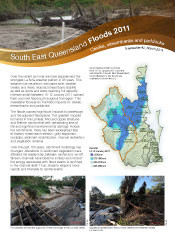Flood newsletter on impacts to creeks, streambanks and paddocks
Bill Dennison ·This newsletter was interesting to put together, as it involved looking through hundreds of photographs of flood damage in the Moreton Bay watershed. Some of the photos were staggering. There were photos of tractors and automobiles crushed like small tin cans, a time sequence of water rising over a farm shed within minutes, streambeds stripped down to the bedrock, and tree roots exposed instead of being buried deep in soil. The choice of photographs for the newsletter was limited by their ability to illustrate key points, having proper resolution for printing and containing attribution and location information.
We also spent time looking at the rainfall map and the 3 dimension catchment map. This combination made it possible to understand the locations of flash flooding as well as the large scale flood plain flooding due to the downstream river levels. The combination of steep sloping hills and intense rain in the upper Lockyer valley created the flash flooding conditions, but the Ipswich and Brisbane flooding was largely through river flooding.
The distinction between flash flooding (water coming 'down') versus river flooding (water coming 'up') is one that is relevant for insurance. Insurance for river flooding, predictable based on maps of previous floods and elevations, is very difficult or impossible to obtain. In contrast, flash flooding from runoff can be insured.
Olwyn Crimp was the lead on this newsletter, and she ushered it through in a timely manner. A broader assemblage of organizations contributed to this newsletter, accounting for the different expertise needed.
About the author
Bill Dennison

Dr. Bill Dennison is a Professor of Marine Science and Vice President for Science Application at the University of Maryland Center for Environmental Science.


